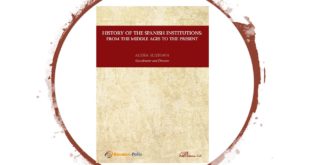
Orlando Figes, author of the newest major cultural history of Russia, is one of the best—possibly the very best—of Britain’s younger historians of Russia. He is primarily known for his monumental La Revolución rusa, 1891-1924 (Edhasa, 2000), the temper of which was expressed by its original title in English, A People’s Tragedy. The latter has been called by more than a few commentators the best one-volume history of the Russian revolution, and it is beyond doubt the best social history.
His massive new volume may be described as a socio-cultural history, for it is not primarily a study of the outstanding modern artistic achievements of Russia, but of the major paradigms or myths of culture and identity within which these achievements took place. The goal is to describe and to probe modern Russian culture in its search for the character and identity of Russia, the revelation of the «true»-or the goal of the «ideal»- Russia.
There was a time when Russia when had a clear identity, based firmly on religion. This was the era of traditional Muscovy, prior to the modernizing and westernizing revolution introduced by Peter the Great at the beginning of the eighteenth century. Old Muscovy had virtually no literature other than narrow and stereotyped religious writings and virtually no instrumental music, instruments being frowned on as seductions of Satan. Its culture was based on religious liturgy and the key spiritual and esthetic role of the icon, both inherited from Byzantium. It will not do to call the traditional culture of Muscovy «medieval,» for it registered few of the major cultural achievements of the western Middle Ages. There were no universities, no scholastic cism, no «Renaissance,» and almost none of the religious development and reform which took place during the western Middle Ages, as well as no limited monarchy, very little development of the law and no real parliament.
Traditional Muscovy constituted a distinct eastern Christian civilization, only distantly related to that of the West. It did develop its own closed and narrow religious culture, as well as its own peasant folk culture, which crystallized in clear and distinctive forms. Its unique cultural achievements were primarily esthetic. Both church and folk music developed completely original forms, in terms of melodies, harmonies and tonal scale, and there also developed a unique style of Russian church architecture.
Old Muscovy also began to expand as a potentially major land empire as early as the sixteenth century, but soon encountered Russia’s perennial modern problem the need for major new transformation to meet the challenges posed by the modern West. Traditional Muscovy also defined the typical Russian response to that problem, which amounted to administrative adjustments by the state and technical reforms by the military to enhance competitive military strength, while eschewing any real modernization of the society or the culture. This became the first Russian «pseudomorphosis,» to use Spengler’s term a change or semi-modernization that remained limited, superficial and incomplete. This first Muscovite pseudomorphosis maintained traditional Russian society and culture intact, and because of that limitation in the long run failed to solve the problem, even though the Muscovite empire continued to expand during the seventeenth century.
The great disjuncture in Russian history was thus effected by Peter the Great, as he added a kind of semi-western cultural revolution to accompany his major state and military reforms, creating a much more drastic pseudomorphosis than that of the preceding era. The Petrine revolution was hugely successful militarily, as the Russian empire entered a century and a half of massive and rapid expansion. Russia became one of the great powers, and for a time the greatest of them militarily, but it also became a fractured and divided
culture, split in an almost schizophrenic way between the modern and western forms and manners of the aristocratic elite and the traditional native folk culture of the vast peasant majority, many of them still bound to semi-slavelike conditions of serfdom.
Like all the modern Russian pseudomorphoses, this one too would fail, but it marks Figes’s point of departure, as he begins the book with a long chapter on the aristocratic but only semi-western Russian culture of the eighteenth century, the first phase of a modern culture that became increasingly self-conscious and self-reflexive. In this era it became fashionable for the nobility to speak mainly French, to the extent that many of them could not really speak literate Russian properly, their use of the native language being based on crude folk forms and vulgar slang learned from their peasant nannies and servants. Count Karl Nesselrode, the highly conservative Baltic German aristocrat who served continuously as the Tsarist foreign minister for an incredible fortyone years (1815- 1856), never learned to speak the language of the empire properly, relying on French and occasionally on German.
Yet by the late eighteenth century this state of affairs was already beginning to become a problem, as a kind of nativist reaction set in among a portion of the aristocracy. Though Figes seems unaware of it, this constituted but the Russian variant of a widespread set of nativist and traditionalist reactions among societies in danger of foreign cultural domination or rapid change. At this point one finds the cultural originsof the new creeds of Japanese «nativism,» of «Wahhabism» in Arabia, and in Spain of what is sometimes called «el pensamiento reaccionario español.» In Russia this meant the beginning of what might be considered the first glimmerings of a modern nationalist response, and of the effort to grasp the nature of Russian culture.
This is related to the metaphor which provides the title for the book, which is taken from a vignette in Tolstoy’s War and Peace in which the aristocratic heroine Natacha suddenly reveals the ability to execute perfectly a peasant dance, which supposedly symbolizes the underlying true cultural identity and unity of Russians. The problem with this metaphor is that the vignette in itself it is not exactly convincing, for at that time the cultural gulf between aristocrats and peasants had become so great that most Natachas were probably incapable of perfectly performing peasant dances. And precisely there lay the problem, for the harmony posited by Tolstoy simply did not exist. Tolstoy himself knew that very well, and ultimately expended his life in a vain attempt to overcome it.
The new nativism which emerged at the end of the eighteenth century would mark the beginning of what Ian Buruma has termed Russian «Occidentalism,» meaning a modern Russian anti-Westernism, which would take a variety of forms, some of them indeed initially borrowed from the West itself. Figes devotes his second long chapter to the consequences in Russian culture of the traumatic encounter presented by the Napoleonic wars and the French invasion of 1812. The first half of the nineteenth century was the time in which the first glimmerings of a more modern society emerged, providing the social background for the extraordinary flowering of the new artistic high culture of the
third quarter of the century. The liberalization of the reign of Alexander I (1801-1825), like nearly all Russian liberalizations, was a transient phenomenon. Figes focuses more on the new «Russianism» of the early nineteenth century, on the initial emergence of the modern «intelligentsia» (one of the comparatively few Russian words to pass into international usage), and of the divergence which produced in this era the beginning the beginning of the revolutionary movement.
Whereas the first chapter dealt with St. Petersburg as the center of the Petrine modernization, the third chapter treats Moscow as the great nativist metropolis, and of the new cultural forms and myths developed there during the nineteenth century. By the end of the nineteenth century Moscow was even beginning partially to displace the imperial capital as the new cultural center and as the seat of specifically Russian forms of cultural modernism, where folk art motifs helped to inspire novel forms of painting and design.
Chapter four treats the great problem of the Russian «people,» that is, of an illiterate, superstitious, semi-primitive and at first partially enserfed peasantry, whose non integration into a modern society became an obsessive problem during the second half of the century. The problem of the peasantry and the role of traditional culture was fundamental to the great reformist divergence between «Westernizers,» who sought the radical imposition of modern western forms, and «Slavophiles,» who sought to reform the traditional society while maintaining as much of the traditional culture and system as possible.
The highly original new literature and music that arose in Russia in crucial ways reflected and sought to wrestle with this problem. The great novels achieved new artistic heights while treating certain psychological and philosophical problems with a depth and acuteness never yet attained in western literature. Russian musical composers in turn developed a new tonal system with novel harmonic devices and heterophonic melodies that could express the original forms of Russian music in modern orchestral composition. The result was the dazzling explosion of a uniquely Russian culture that expressed its pristine contents in universally recognizable modern forms.
Towering artistic achievement, however, had little impact on the basic social and cultural problems. By the end of the century a harmonious transformation of society, government and common culture seemed almost as remote as ever, while new changes and social mobilization made an alienated society more vocal, more resentful and by thattime even increasingly dangerous, as the social and cultural problem was being transformed into a radical political challenge.
The other major parts of the book treat religious culture, Russian messianism and religious divergence, the increasingly perplexing issue of the cultural relationship with eastern societies, cultural change under the Soviets and the post-1917 phenomenon of Russian émigré culture. The discussion of religious issues is insightful and fruitful, and these themes probably merit even more attention, particularly with regard to the perennial issue of Russian messianism.
Figes shows that by the 1880s study of Tatar, Turkish, Mongol and other oriental influences on Russian society and culture was becoming obsessive. This revealed the hitherto never fully recognized extent of such influences and motifs, not just in technical names (as in the Arabic words in Spanish), but in some of the most intimate areas of Russian society and culture, from clothing and food even to certain facets of religiosity. These factors were not merely recognized and appreciated for the first time, but also not infrequently exaggerated, giving rise to the «Eurasianist» theories of a partially oriental character and vocation of Russia that still remain influential in the twenty-first century.
By comparison, the final chapters on the cultural expression of the Soviet era and of the émigrés are the least original and least useful. This may simply be due to the fact that Soviet-era culture is already broadly studied, while that of the émigrés registered only a few notable achievements.
The modus operandi of the book makes great use of social history, as might be expected from Figes, structured around much biographical information concerning leading cultural and social figures. The general organization, as has been indicated, rests on a combination of the chronological and thematic. Neither of the latter is fully satisfactory, for the basic themes overlap chronological eras and are also mutually interwined, so that they have to be approached both from different periods and different perspectives. Figes emphasizes that each era and each cultural focus of modern Russia generated new, though sometimes interrelated, myths which sought to make sense of Russia’s historical and cultural predicament and lay down new concepts and guidelines to define the country’s identity and to solve its problems.
The specifically political issue of a Russian nationalism and its ideology is treated only obliquely through cultural paradigms and might have deserved more direct analysis, even though it goes beyond strict cultural study. Similarly, it would have been helpful to treat more directly the persistent role of «grand empire» in modern Russian history as a means of complicating identities and rendering them more complex and confused, or confusing.
Figes writes vividly and well, and encompasses a vast panorama. The book is rich in substance, though a work of such scope is inevitably somewhat uneven. Several of the early reviews of the original English-language edition pointed out a number of errors in detail as well as an embarrassing minor instance of plagiarism from Geoffrey Hosking’s Russia: Peopleand Empire (1997). Such blemishes do exist, but in general do not detract greatly from a work of remarkable scope and often compelling content, which will rightly prove fascinating to a great many readers.
The problems that caused such deep ambivalence and anguish to Russia’s great cultural figures and social reformers were not always the problems of Russia alone, but produced a dizzying array of new Russian responses to modernity, some of them destructive dead-ends, but often with great impact and resonance outside Russia. These include the first systematic modern political terrorism, the revolutionary doctrines of anarchism, Marxism-Leninism and one-party totalitarian dictatorship, unique new forms of modern art in literature, music, ballet and painting, Tolstoyan pacifism and Kropotkinist cooperativism, and even a new modern form of political anti-semitism. There is no denying the great influence of the proposed Russian alternatives, for good or ill (probably more the latter), on the world of the late nineteenth and twentieth centuries.
The book ends without any convincing conclusion, perhaps because the basic problems with which it deals were never effectively solved and still have reached no final resolution. During the decade of the 1990s Russia’s leading politicians found it necessary to release position papers not so much on technical political and economic problems as on broad theoretical problems of national identity. All this is still very much on Russia’s agenda for the twenty-first century.
- identidad cultural
- rusia
 Kosmospolis Revista digital de Historia, Política y Relaciones Internacionales kosmos-polis
Kosmospolis Revista digital de Historia, Política y Relaciones Internacionales kosmos-polis






